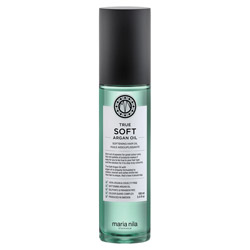Why Frizz Happens
It is key to understand the anatomy of hair when trying to figure out what your hair needs. The follicle, which is embedded beneath the surface of the scalp, is the only part of the structure that is alive. Blood flow delivers vital nutrients to this base and provides the beginnings of healthy hair. That said, you now understand why we stress that you nourish your hair from the inside, in order to begin and maintain health on the outside. So in essence you can prevent frizz before it starts by incorporating hair-healthy foods into your diet and providing your hair with the essential building blocks for strength and health.
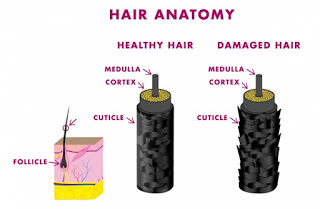
Beyond the follicle we have the shaft of the hair which has a three layers, the outermost layer is called the cuticle layer. Under a microscope your hair would resemble a roof covered in overlapping shingles. These "shingle like" structures make up the cuticle and when your hair is healthy and fortified with protein the cuticle is closed and the layers are flush against one another. As your hair becomes damaged the cuticle lifts up and is now porous, allowing water (and other pollutants) to pass through and damage the hair. When the cuticle layer has lifted too much your hair is vulnerable to not only long term damage but can also become frizzy. If left unchecked the open cuticle will become susceptible to damage.
Frizz is caused when hair is dry and lacks moisture. When your hair is dry, the cuticle is rough, and when the weather is humid, it's the perfect recipe for frizz. The outer layer of the hair takes in the moisture from the air, causing the hair to swell and frizz. The cuticle "shingles" open up when exposed to the moist humidity.
Are you part of your hair's frizz problem?
With countless anti-frizz products on the market, you'd think it would be easy to keep frizz at bay. But sometimes it feels like no matter how much stuff you put in your hair to stop it. As it turns out, you might be part of the reason for your hair's frizz. Below, check out the seven things you could be doing that actually make your hair frizzier.
Using sulfates - strong detergents that are often added to shampoos - have been shown to add frizz and dry out the hair. Sulfates can also strip hair of natural oils that keep it moisturized,
Products that contain alcohol can also dry out the hair, leaving it brittle and prone to frizz. The alcohol actually absorbs the moisture your hair needs to combat frizz. Instead, try using hair oils or styling cremes, which can help lock in moisture and keep hair looking shiny.
Washing your hair with very hot water can actually strip the hair of the natural oils that keep it moisturized and smooth. So, if you're prone to frizz, you might want to try easing up on the heat.
Touching hair can create frizz if your skin has moisture in it. Playing with your hair too much when it's wet can also disrupt curl patterns or wave patterns. Apply styling products to soaking wet hair and then resist the urge to touch your hair until it's completely dry. Otherwise, curls lose their definition and get frizzy. The more you touch, the more frizz you create, so hands off!
Scrunching your hair up in a towel right after a shower may seem like a convenient way to dry it, but it won't do you any favors when it comes to preventing frizz. Towel-drying essentially roughs up the hair cuticle, which can cause it to lift up instead of lie flat. When your hair is wet, it is at its most fragile state. Do not wrap your hair in a towel turban-style. If your hair is prone to frizz, invest in a microfiber towel to gently absorb excess moisture while keeping frizz at bay. Simply use the towel to blot the hair, then do not touch, and let it air dry.
Whether you use a blow dryer, flat iron or curling iron, daily high heat from hair tools can damage the hair and strip it of moisture, leading to frizz. Minimize the use of heated styling tools (if you can) and let your hair air dry. If you do need to use heat, use the lowest setting and always make sure to protect the hair with a thermal protectant spray before styling. Use a blow dryer with ionic technology, which produces natural negative ions to smooth the hair cuticle. Another way to prevent frizz if you're using a blow dryer is to use the smoothing nozzle and blow dry in the direction of hair growth - that is, from the roots to the ends - to seal the cuticle.
Brushing can help with untangling your locks, but it's not always great for keeping frizz at bay, especially if you're planning to skip the blow dryer. On hair that you're going to blow out, you do need to brush from root to tips to distribute naturally occurring scalp oils. But if you're planning on letting your hair dry naturally, brushing it could just disrupt the outer layer and cause frizz. Brushing hair can actually stretch your strands and lead to breakage. When hair is wet, simply rake styling product through the hair with your fingers, and then hands off. If you're brushing your hair while it's dry, make sure you're being gentle and not just ripping through it.
What's the RIGHT way to keep the frizz away?
If you're trying to keep your hair looking shiny and smooth, all hope is not lost. The first thing you need to do, however, is to identify your hair type. Is it fine? Curly or wavy? Damaged or dry? From there, you'll be able to choose a product that is the most appropriate for your hair.
For fine hair, hairspray is often enough to tame frizz, while wavy and curly girls should opt for a cr�me or mousse to add moisture.
Silk pillowcases and scarves for sleeping - good for all hair types - which can help decrease friction that causes frizz.
Apply styling products to soaking wet hair, as opposed to towel-dried hair to add a protective layer against frizz.
Use a leave-in conditioner or moisturizing mask at least once a week to restore moisture and nourish dehydrated, frizzy hair.
Argan oil is a good choice for adding weightless moisture and shine to hair. Unlike other oils, like coconut or olive, the oil molecules found in argan oil are small enough to penetrate the hair shaft, making it instantly, deeply moisturizing, which helps treat and strengthen strands without weighing them down.
One ingredient you might want to avoid: silicone. Products with silicones can create a barrier around the hair to prevent humidity from entering the cuticle and causing frizz, however, products with silicones, which are waxes, will keep frizz at bay, but they tend to build up with repeated use and coat the hair, making it flat, dull and lifeless. Silicone serums just coat the hair, giving the appearance of shine, but don't actually add moisture to the hair strands to help fight frizz in the long run.


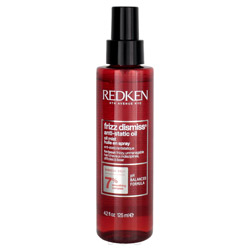
 write a review
write a review
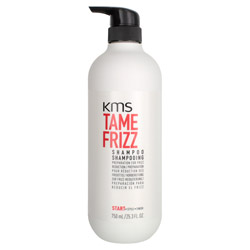
 write a review
write a review
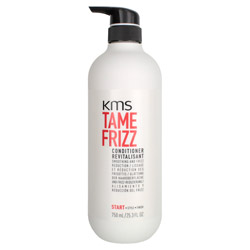
 write a review
write a review
